My guess is that there's no index on ParentItem.
And with 3 joins on that field, the full table scans make it slow.
But ID is probably the primary key, so that's indexed.
If adding an index on ParentItem isn't an option?
Then you could go via a temporary table with an index on the parent.
CREATE TABLE #tmpItem (ParentID int, ID int);
INSERT INTO #tmpItem (ParentID, ID)
SELECT ParentItem, ID
FROM dbo.Item;
CREATE CLUSTERED INDEX #IDX_C_tmpItem ON #tmpItem(ParentID);
SELECT --TOP (100) PERCENT
Item_0.ID AS ID,
Item_0.ItemLookupCode AS ItemLookupCode,
Item_0.UnitOfMeasure AS UnitOfMeasure,
Item_1.ID AS ChildID1,
Item_1.ItemLookupCode AS ChildItemLookupCode1,
Item_1.ParentItem AS ChildParentItem1,
Item_1.UnitOfMeasure AS ChildUOM1,
Item_2.ID AS ChildID2,
Item_2.ItemLookupCode AS ChildItemLookupCode2,
Item_2.ParentItem AS ChildParentItem2,
Item_2.UnitOfMeasure AS ChildUOM2,
Item_3.ID AS ChildID3,
Item_3.ItemLookupCode AS ChildItemLookupCode3,
Item_3.ParentItem AS ChildParentItem3,
Item_3.UnitOfMeasure AS ChildUOM3
FROM (
SELECT I0.ID as ID0, I1.ID as ID1, I2.ID as ID2, I3.ID as ID3
FROM #tmpItem AS I0
LEFT JOIN #tmpItem AS I1 ON (I0.ID = I1.ParentID)
LEFT JOIN #tmpItem AS I2 ON (I1.ID = I2.ParentID)
LEFT JOIN #tmpItem AS I3 ON (I2.ID = I3.ParentID)
) Q
LEFT JOIN dbo.Item Item_0 ON Q.ID0 = Item_0.ID
LEFT JOIN dbo.Item Item_1 ON Q.ID1 = Item_1.ID
LEFT JOIN dbo.Item Item_2 ON Q.ID2 = Item_2.ID
LEFT JOIN dbo.Item Item_3 ON Q.ID3 = Item_3.ID;
Below is just an experiment in using a recursive query.
Making use of the index on ID.
Yes I know, it doesn't return parents without children. Please don't judge.
declare @Item table (ID int primary key, ItemLookupCode varchar(11), UnitOfMeasure varchar(3), ParentItem int);
insert into @Item (ID, ItemLookupCode, UnitOfMeasure, ParentItem) values
(111,'100006C0005','CRT',0), (112,'100006B0001','BAG',111),
(221,'100027C0002','CRT',0), (222,'100027T0012','PCT',221), (223,'100027P0001','PC',222),
(224,'100027X0001','XX',223),(225,'100027Y0001','YY',223),
(226,'100027Z0001','ZZ',225);
WITH RCTE AS
(
select ID as StartID, 0 as PrevID, 0 as Level, ID, ParentItem as ParentID, ItemLookupCode, UnitOfMeasure
from @Item
union all
select RCTE.StartID, RCTE.ID, RCTE.Level + 1, t.ID, t.ParentItem, t.ItemLookupCode, t.UnitOfMeasure
from RCTE
join @Item t on (RCTE.ParentID = t.ID)
)
select
max(case when ReverseLeveL = 0 then ID end) as ID0,
max(case when ReverseLeveL = 0 then ItemLookupCode end) as ItemLookupCode0,
max(case when ReverseLeveL = 0 then UnitOfMeasure end) as UnitOfMeasure0,
max(case when ReverseLeveL = 1 then ID end) as ID1,
max(case when ReverseLeveL = 1 then ItemLookupCode end) as ItemLookupCode1,
max(case when ReverseLeveL = 1 then UnitOfMeasure end) as UnitOfMeasure1,
max(case when ReverseLeveL = 2 then ID end) as ID2,
max(case when ReverseLeveL = 2 then ItemLookupCode end) as ItemLookupCode2,
max(case when ReverseLeveL = 2 then UnitOfMeasure end) as UnitOfMeasure2,
max(case when ReverseLeveL = 3 then ID end) as ID3,
max(case when ReverseLeveL = 3 then ItemLookupCode end) as ItemLookupCode3,
max(case when ReverseLeveL = 3 then UnitOfMeasure end) as UnitOfMeasure3
from (
SELECT *, row_number() over (partition by StartID order by Level desc)-1 as ReverseLeveL
from RCTE
where Level <= 3
) Q
group by StartID
having max(case when ReverseLeveL = 1 then ID end) is not null;

